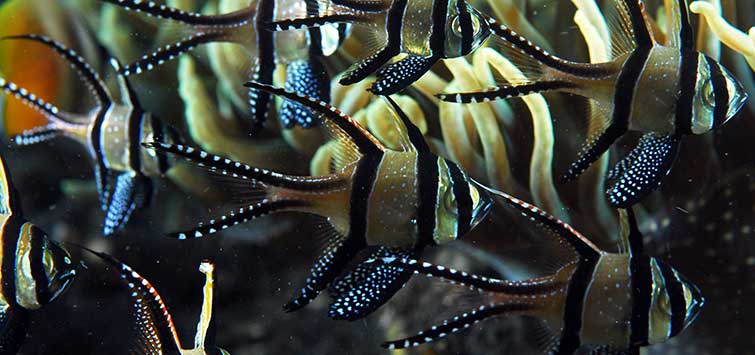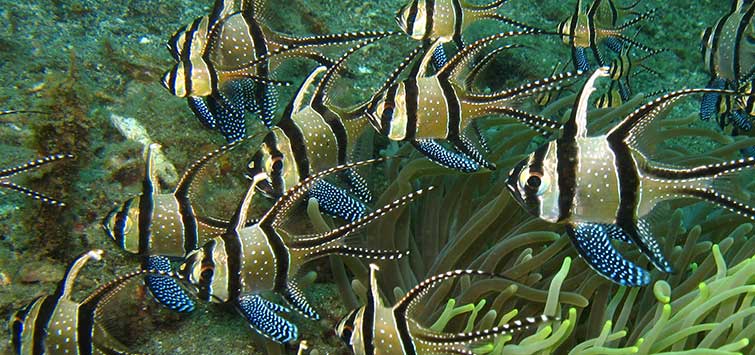Dr. Alejandro Vagelli and the Banggai Cardinalfish
Author: Shari Horowitz
Dr. Alejandro Vagelli is on the leading edge of the Banggai cardinalfish controversy after studying them at his lab in the New Jersey Academy for Aquatic Sciences, and applying for their CITES protection. TFH’s own Associate Editor meets with Dr. Vagelli to discuss the precarious situation faced by these fish and what it will take to ensure their survival in the wild.
The Accident
It all started as a kind of weird accident. In 1996 two unidentified fish were added to the New Jersey State Aquarium’s new exhibit on the Indo-Pacific. After a while, the pair bred and the aquarium had a “pregnant” male on its hands. Someone brought the mouthbrooding male into the lab of Dr. Alejandro Vagelli, the Director of Science and Conservation for the New Jersey Academy for Aquatic Sciences, the not-for-profit organization that operated the aquarium at the time. (In 2005, the aquarium was expanded and is now operated as Adventure Aquarium. The Academy continues to pursue its missions of education and research in partnership with Adventure Aquarium.)
After some research, Vagelli was able to identify the fish as a Banggai cardinalfish Pterapogon kauderni, but the only information available about the fish was the original one-page description of the species published in 1933 and an article that introduced the fish to the aquarium hobby published in the May 1996 issue of Tropical Fish Hobbyist.
“That brooding cardinalfish changed my professional career,” Vagelli said in his lab, which is now packed with photos and papers relating to the Banggai cardinalfish, most of which were taken or written by him. Vagelli became curious about the fish precisely because of the lack of information about them. He spoke to Dr. Gerald Allen, the expert on Indo-Pacific fish at the time, and obtained some specimens. Vagelli’s initial interest in the fish stemmed from the odd fact that it was a coral reef fish producing very large eggs, but that interest grew exponentially when it became apparent that wild populations were limited and quite possibly in peril.
Science and Discovery
It quickly became clear that studying these fish would not be easy—even filming the egg transfer was difficult, since it took a mere 1.5 seconds, and it was inevitably the 1.5 seconds that Vagelli was on the phone or at the door, back when he could not get a clear picture without standing there to zoom in and focus. There was almost no specific information about the reproduction of these fish, so it took a while for him to learn that Banggai cardinals are unique among coral reef teleosts. Unlike most marine fish, they produce huge eggs, lack a larval stage (exhibit direct development), have low fecundity, and undergo a long period of parental care.
This interesting information and Vagelli’s innate sense of adventure led him to plan a trip to Indonesia’s isolated Banggai Archipelago to learn about their distribution and ecology. He found that reproduction was not the only area where these fish differed from their coral reef counterparts—even neighboring populations differ widely from a genetic standpoint because of isolation caused by a lack of movement of individuals between groups. He discovered that the fish are associated with a wide variety of habitats and microhabitats (living substrates), but their habitat preference is not related to their life stage. They will eat almost anything—in fact, some new species were discovered after analyzing their stomach contents. Banggai cardinalfish also turned out to be the only cardinalfish that is diurnal.
Besides uncovering the quirks of the fish, Vagelli found some disturbing information while he was there. The reefs of the Banggai Islands, which were relatively unexplored because of their extreme isolation, were being destroyed by dynamite and cyanide fishing. Through interviews with the locals, he additionally learned that at least a million fish were being collected annually, and there was high mortality among collected individuals.
Politics and Preservation
It was the unique characteristics of the Banggai cardinalfish that made them exceptionally vulnerable to overfishing. The fact that the fishes are associated with living substrates and are diurnal makes them easy to catch. Low fecundity, and even lower survival after release, means that it is difficult for the fish to recover from a large fishing event. And since they will eat a wide variety of foods and are peaceful in a community setting, they make for very popular aquarium inhabitants.
There was no preservation effort at the time in Indonesia, and cardinalfish populations were declining precipitously, so Vagelli went back to the states to make his plea. He appealed to the Fish and Wildlife Service (FWS) and the National Oceanographic and Atmospheric Administration (NOAA) to include these fish at the Convention on International Trade in Endangered Species (CITES) conference and to list Pterapogon kauderni as at least Appendix II. Even though it is unusual for a country to submit a species not found within that country, FWS and NOAA agreed to go ahead with the proposal, but due to the proximity to the 2004 deadline, they decided to make the proposal for 2007.
“I never thought I’d be embroiled in politics,” Vagelli said about the proposal and the aftermath. The entire story of what happened at the CITES convention is currently being published by Vagelli, but he says it was politically and economically motivated. Vagelli is thinking about re-submitting the proposal for the convention in 2010, and he is hoping that the new listing of the Banggai cardinalfish as “endangered” on the IUCN Red List of Threatened Species will help motivate CITES to put Pterapogon kauderni on an appendix and start regulating trade.
Current Work
In the meantime, Vagelli’s lab no longer has live Banggai cardinalfish, and there are only a few in the entire aquarium. He still wants to study different topics related to Banggais, including a look at why juvenile Banggai cardinalfish are able to swim within an anemone, even though juvenile clownfish can be eaten by an anemone in an aquarium. He is also trying to determine how mouthbrooding evolved in the family Apogonidae, which is why he is now working with different species of cardinalfishes, among them the Australian or black cardinalfish Quinca mirifica (considered by some to be Pterapogon mirifica).
The black cardinalfish is the closest relative of the Banggai cardinalfish, and the two fish share many similarities. The black cardinal is relatively unknown, with only one paper based on a preserved specimen written 20 years ago. It has some unique features, including the fact that it lives as a solitary individual.
The black cardinalfish is remarkable for the brief—but radical—color changes it undergoes when breeding, turning from black to white in a matter of seconds while mating. Vagelli is also conducting some embryological evolutionary studies with one of the oldest arthropods on the planet—the horseshoe crab.
Looking to the Future
Even though he is no longer working with them directly, Vagelli spends much of his time making presentations on the Banggai cardinalfish for those who are interested. He is considering applying for protection of the Banggai cardinalfish under the United States Endangered Species Act. If successful, the act would forbid the fish from being imported, therefore removing a large portion of the demand for the fish worldwide. He also believes that if the United States bans trade of the fish, the European Union is more likely to follow suit, and the collecting pressure would be greatly reduced, if not removed entirely.
In order to help the indigenous people of the Banggai Islands, Vagelli has a plan to develop in situ aquaculture facilities that could be run by locals and hopefully produce Marine Aquarium Council (MAC)-certified fish. The catch, he explained, is that currently the fish are captured relatively easily with nets. Even though the captive-bred specimens would fetch a higher price and therefore earn the breeders more money, they could not compete with the ease of capture in the wild. However, if fishing for them becomes illegal, Vagelli’s plan would have much higher odds of working.
As a more immediate method, Vagelli is also appealing to the hobbyists themselves and trying to start a grassroots movement with his presentation, “Conscientious Banggai Keepers.” He asks that hobbyists spend a little more money to ensure that they are obtaining captive-bred specimens instead of defaulting to wild-caught. He added that the value of the captive-bred fish is probably higher anyway, since there is extremely high mortality among wild-caught fish. Finally, people with Banggai cardinalfish could try to breed them at home, since they are a relatively easy-to-breed marine fish, and there is a wealth of information about raising juveniles.
Vagelli’s message is simple: “Hobbyists have the power to decide the future of the species.”
See the full article on TFH Digital http://www.tfhdigital.com/tfh/200902/#pg95

.png?h=595&iar=0&w=2781&hash=5FD5E69473BCC22199FBFA2FB71B6033)



